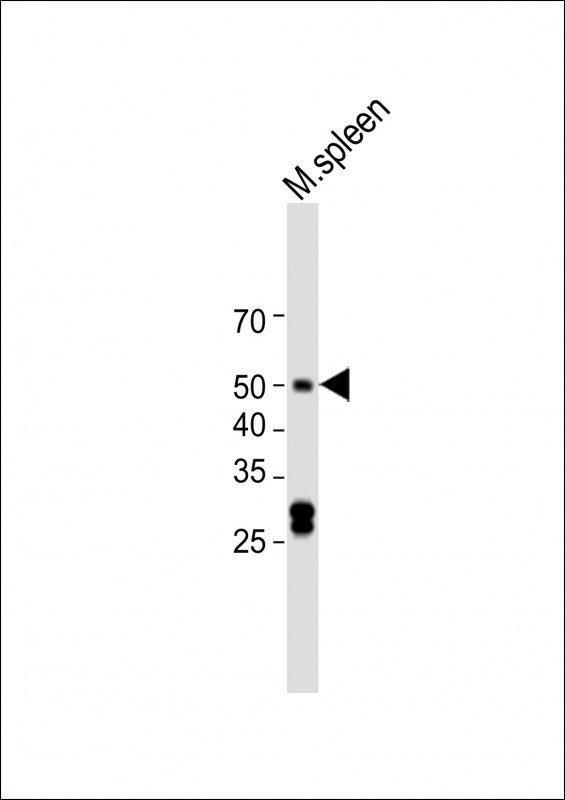PABPN1 Antibody (C-term)
Affinity Purified Rabbit Polyclonal Antibody (Pab)
- 产品详情
- 实验流程
- 背景知识
Application
| WB, E |
|---|---|
| Primary Accession | Q86U42 |
| Other Accession | Q28165, NP_004634.1 |
| Reactivity | Human |
| Predicted | Bovine |
| Host | Rabbit |
| Clonality | Polyclonal |
| Isotype | Rabbit IgG |
| Calculated MW | 32749 Da |
| Antigen Region | 270-298 aa |
| Gene ID | 8106 |
|---|---|
| Other Names | Polyadenylate-binding protein 2, PABP-2, Poly(A)-binding protein 2, Nuclear poly(A)-binding protein 1, Poly(A)-binding protein II, PABII, Polyadenylate-binding nuclear protein 1, PABPN1, PAB2, PABP2 |
| Target/Specificity | This PABPN1 antibody is generated from rabbits immunized with a KLH conjugated synthetic peptide between 270-298 amino acids from the C-terminal region of human PABPN1. |
| Dilution | WB~~1:1000 E~~Use at an assay dependent concentration. |
| Format | Purified polyclonal antibody supplied in PBS with 0.05% (V/V) Proclin 300. This antibody is prepared by Saturated Ammonium Sulfate (SAS) precipitation followed by dialysis against PBS. |
| Storage | Maintain refrigerated at 2-8°C for up to 2 weeks. For long term storage store at -20°C in small aliquots to prevent freeze-thaw cycles. |
| Precautions | PABPN1 Antibody (C-term) is for research use only and not for use in diagnostic or therapeutic procedures. |
| Name | PABPN1 (HGNC:8565) |
|---|---|
| Synonyms | PAB2, PABP2 |
| Function | Involved in the 3'-end formation of mRNA precursors (pre- mRNA) by the addition of a poly(A) tail of 200-250 nt to the upstream cleavage product (By similarity). Stimulates poly(A) polymerase (PAPOLA) conferring processivity on the poly(A) tail elongation reaction and also controls the poly(A) tail length (By similarity). Increases the affinity of poly(A) polymerase for RNA (By similarity). Is also present at various stages of mRNA metabolism including nucleocytoplasmic trafficking and nonsense-mediated decay (NMD) of mRNA. Cooperates with SKIP to synergistically activate E-box-mediated transcription through MYOD1 and may regulate the expression of muscle- specific genes (PubMed:11371506). Binds to poly(A) and to poly(G) with high affinity (By similarity). May protect the poly(A) tail from degradation (By similarity). Subunit of the trimeric poly(A) tail exosome targeting (PAXT) complex, a complex that directs a subset of long and polyadenylated poly(A) RNAs for exosomal degradation. The RNA exosome is fundamental for the degradation of RNA in eukaryotic nuclei. Substrate targeting is facilitated by its cofactor MTREX, which links to RNA-binding protein adapters (PubMed:27871484). |
| Cellular Location | Nucleus. Cytoplasm. Nucleus speckle Note=Localized in cytoplasmic mRNP granules containing untranslated mRNAs. Shuttles between the nucleus and the cytoplasm but predominantly found in the nucleus (PubMed:10688363). Its nuclear import may involve the nucleocytoplasmic transport receptor transportin and a RAN-GTP- sensitive import mechanism (By similarity). Is exported to the cytoplasm by a carrier-mediated pathway that is independent of mRNA traffic. Colocalizes with SKIP and poly(A) RNA in nuclear speckles (By similarity). Intranuclear filamentous inclusions or 'aggregates' are detected in the myocytes of patients; these inclusions contain PABPN1, ubiquitin, subunits of the proteasome and poly(A) RNA {ECO:0000250|UniProtKB:Q28165, ECO:0000269|PubMed:10688363, ECO:0000269|PubMed:11001936, ECO:0000269|PubMed:11371506, ECO:0000269|PubMed:14663186, ECO:0000269|PubMed:17289661, ECO:0000269|PubMed:27209344} |
| Tissue Location | Ubiquitous. |
For Research Use Only. Not For Use In Diagnostic Procedures.
Provided below are standard protocols that you may find useful for product applications.
BACKGROUND
This gene encodes an abundant nuclear protein that binds with high affinity to nascent poly(A) tails. The protein is required for progressive and efficient polymerization of poly(A) tails on the 3' ends of eukaryotic genes and controls the size of the poly(A) tail to about 250 nt. At steady-state, this protein is localized in the nucleus whereas a different poly(A) binding protein is localized in the cytoplasm. An expansion of the trinucleotide (GCG) repeat from normal 6 to 8-13 at the 5' end of the coding region of this gene leads to autosomal dominant oculopharyngeal muscular dystrophy (OPMD) disease. Multiple splice variants have been described but their full-length nature is not known. One splice variant includes introns 1 and 6 but no protein is formed.
REFERENCES
Hosgood, H.D. III, et al. Occup Environ Med 66(12):848-853(2009)
Hurt, J.A., et al. J. Cell Biol. 185(2):265-277(2009)
Kuo, H.C., et al. J. Neurol. Sci. 278 (1-2), 21-24 (2009) :
Tavanez, J.P., et al. PLoS ONE 4 (7), E6418 (2009) :
Maksimova, N.R., et al. Zh Nevrol Psikhiatr Im S S Korsakova 108(6):52-60(2008)
终于等到您。ABCEPTA(百远生物)抗体产品。
点击下方“我要评价 ”按钮提交您的反馈信息,您的反馈和评价是我们最宝贵的财富之一,
我们将在1-3个工作日内处理您的反馈信息。
如有疑问,联系:0512-88856768 tech-china@abcepta.com.























 癌症的基本特征包括细胞增殖、血管生成、迁移、凋亡逃避机制和细胞永生等。找到癌症发生过程中这些通路的关键标记物和对应的抗体用于检测至关重要。
癌症的基本特征包括细胞增殖、血管生成、迁移、凋亡逃避机制和细胞永生等。找到癌症发生过程中这些通路的关键标记物和对应的抗体用于检测至关重要。 为您推荐一个泛素化位点预测神器——泛素化分析工具,可以为您的蛋白的泛素化位点作出预测和评分。
为您推荐一个泛素化位点预测神器——泛素化分析工具,可以为您的蛋白的泛素化位点作出预测和评分。 细胞自噬受体图形绘图工具为你的蛋白的细胞受体结合位点作出预测和评分,识别结合到自噬通路中的蛋白是非常重要的,便于让我们理解自噬在正常生理、病理过程中的作用,如发育、细胞分化、神经退化性疾病、压力条件下、感染和癌症。
细胞自噬受体图形绘图工具为你的蛋白的细胞受体结合位点作出预测和评分,识别结合到自噬通路中的蛋白是非常重要的,便于让我们理解自噬在正常生理、病理过程中的作用,如发育、细胞分化、神经退化性疾病、压力条件下、感染和癌症。






